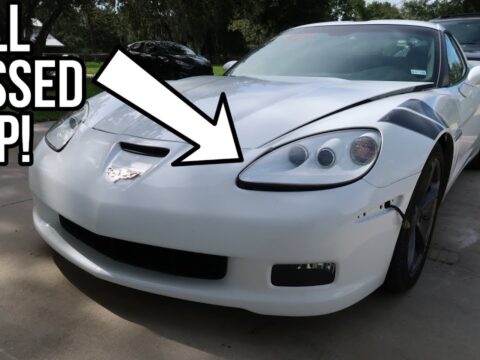How To Perform A Leak Down Test – EricTheCarGuy
At long last I was finally able to put up a leak down test video for you and the really good news is that I will be replacing the engine in this truck and I hope to shoot some video of the process, I also hope to be able to take apart the old engine to examine the fault that caused the excessive compression loss in this engine so keep your eyes out for that.
—
Click below and Stay Dirty
Visit me at EricTheCarGuy.com
Visit EricTheCarGuy Forum
http://www.ericthecarguy.com/forum/default.aspx
Visit my Facebook Page:
http://www.facebook.com/EricTheCarGuy
—
Stay dirty
ETCG
Due to factors beyond the control of EricTheCarGuy, it cannot guarantee against unauthorized modifications of this information, or improper use of this information. EricTheCarGuy assumes no liability for property damage or injury incurred as a result of any of the information contained in this video. EricTheCarGuy recommends safe practices when working with power tools, automotive lifts, lifting tools, jack stands, electrical equipment, blunt instruments, chemicals, lubricants, or any other tools or equipment seen or implied in this video. Due to factors beyond the control of EricTheCarGuy, no information contained in this video shall create any express or implied warranty or guarantee of any particular result. Any injury, damage or loss that may result from improper use of these tools, equipment, or the information contained in this video is the sole responsibility of the user and not EricTheCarGuy.















![Suspects for Homicide in the 15th District [VIDEO] – Blotter](https://avnblogfeed.com/wp-content/uploads/2024/04/Homicide-1500-Arrott-St-DC-24-15-022045-100x100.jpg)





I have considered doing a gasket repair with a product to fix my leaking head gasket. But its not leaking coolant, its leaking compression from the gasket being blown-out direct CL (between #3 and #4 ) The only option I see is new gasket! I don't like the way the burnt spot on top of deck block (cast iron) looks burnt. If there were to be a low spot here from high temp melting, it would mean the block needs resurfacing which I don't want to remove.
I was wondering if JB weld extreme high heat paste could be applied on the beck block at point where burnt spot was. A thin layer spot to level-out surface and if it would bond well enough to build a heat resistant barrier. The spot would be under the gasket circular ring area so the gasket would compress down over it after JB weld has cured. The product has a 1000F resistance to heat pressure. Has anyone ever tried this before and what were the results? Serious minds please
I just ran across this video. I'm learning how to do this very test so thank you for making it sound and look easy!
Hello Eric. I think you should do a remake of this video doing the test in the day light. Also zooming in on the areas where you installing the hoses and places you will check for leaks
Don’t bother with China or tawain junk bullshit this government is ripping you off left and right and up and down these importers are nothing but traitors
What the hell has the USA become
100% Leakage and you’ll be replacing cylinder head in harbor freight shit junk should be sued for selling this shit
I gathered evidence dont buy this junk
Harbor freight is junk don’t bother buying it
Great Video, good Knowledge, Clear
Information..👍
Do you have a video of how it would go if there was a stuck or burnt valve
It didn't seem the cylinder 6 was getting consistent spark
Enjoy the way you teach.
Chunky etcg hahaha
You never turned the air on. That's why u had 100 percent leakage. U had just calibrated it that's why it was at 0 then u hooked it to the motor and the air u used to calibrate it escaped. Then u just left the air off. Other wise the left Guage would have had a psi reading.
I think I have a bent valve. It's not quite a knock but it's not a tick either. I think I'm going to do the compression and leakdown test to verify. Thank you. I always was curious about how to do one.
You forgot to open the air regulator on the leak down tester. That's why it didn't work.
This guy is a heavy piece of artillery for any mechanics or Diy guys arsenal. Loved the descriptions that are given on not only problems that you run into, but ones that may be encountered as well. If you are thirsty for knowledge this is the place to be.
Watched a girl do a test and she had a great idea on TDC locate. She used the oil dip stick in the plug hole. It's alway's handy with the engine and should be clean.
You're supposed to crank the air pressure up to 100psi on those testers with the regulator. Not just form it until you get 0 on percent leakage. As soon as you hooked it to cylinder, you're very little air pressure dropped ot to zero. That's why you didn't hear anything leaking.
I like the way you think. Many years ago I took an air regulator, gauge, and a few fittings and made an air source I could regulate for painting and found it also worked well for pressure testing the crankcases on two cycle snowmobile engines. So it should do as well to do leak down tests. Great video..I once had a guy I worked for tell me it wasn't about how many tools in your shop but how well you used the ones you had. you remind me of me. Thanks.
I think when you went passed 0 you threaded the regulator too far back. You should have leaked the tester and recalibrated to 0 slowly. Thats why it didnt hiss. Take the adjustment up really slowly. But thanks for the video, now I have to try my car!
Now this is information to use!
I'm thinking that once he had the 100% leakdown he could have upped the psi going in with the gauge regulator until he had enough flow to hear the leakage location
Hey Eric, what about finding TDC with the compression testing gauge? wait for a bump in the pressure to see if the valves are closed during piston rise?
Excellent analysis Eric. You are a very effective teacher.
Thanks Eric,good vid but that leakdown tester makes me nervous.i have not had good luck with regulators on Harbor Freight tools . Cheers
You make me wanna do a leak down test just for fun. Great videos, I learn something every time
What do you do if you suck the teepee wad down the cylinder hole instead?
Probably the dam computer $5000.00 1990. Mine went bad and gave me an irregular cylinder misfire code. Chevy is a piece of garbage.
Is it possible to do a leak down test even if the engine won't stay running
pull the regulater (black part down ) it has a lock
Starts at 11:35
Lol this guy I wish I would have watched his compression tester hack before I spent 150 bucks on a leak down tester today didn’t even think of it!!
Super late but…pull the regulator adjustment handle down listen for click then turn to adjust pressure
Thanks mate helps a lot.
Leak down rest would be good when testing engine not in the car for a indication of its health apart from bearings.
damn this was so informative !!! thank you
great vid. thanks
I love your videos. Every time I need to work on my car, you have a video.
That tool is junk and that’s not how you do a cylinder leak down test.
Are you Patrick Warburton's brother?
Instead of a screwdriver, why not use a 1/4 inch hose. It is stiff enough to move up (or down if you pass the TDC )and it is much safer too. No?
U sure u didn't use the wrong hose? Schrader valve still in it?